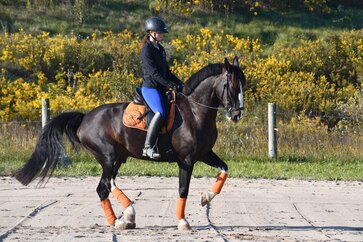 This week I had someone wanting to know about how to engage the hindquarter and lift the back. Really these two things go hand in hand-- when the back is down in most cases the horse cannot properly push from the hind leg. I think with breed the DHH, Morgan, Friesian, Arab, etc it can be a much more difficult process to get them willing to come through their back. A lot of the time these kinds of horses do have what we call "false engagement" because while their hindleg may step under or articulate well, it does not actually have "push" or "sit". You want to think of the hind leg like a coil spring-- it compresses when on the ground and takes the weight so the shoulder can properly lift. I think there should always be two basic concepts that you should check on when working towards asking for engagement. The first is does the horse willingly move freely through its body-- ie if you give the rein does he fall flat on his face and run away? Can you give the rein and not lose any resemblance of horizontal balance. The next is does the horse accept the leg aid as being something more than to run away from? This one is multipart. First-- can you perform a turn on the forehand. Halt, take one leg against the horse -- does he move away from the pressure? Lean into it? or just try to move forward away from it? If he does not just shift the haunch then that is something that needs to be worked on. When we train lateral movements, we have to ensure when we take the leg against the horse that he is going to be willing to move where we ask without running forward(away from it)-- because then we are going to catch him in the mouth and the back is going to more than likely hollow. From these two basics than we ask the horse to be accepting of a "half - halt" with the leg on. This is VERY important down the road. The horse always must think push from the hindquarter even in downward transitions. Your leg and seat are directly correlated to creating a horse who sits and pushes with the hindleg, versus one that hollows. So if you sit with your pelvis forward and back hollow, you are stopping the proper energy that is going from the hindleg to the bit. It is important that we sit over the horse in a way that doesn't prevent the energy from flowing properly through the horse's body, and also that we watch our hands. If our hands are stiff and rigid -- from the elbow to the hand-- then we are going to be likely to cause the horse to also become stiff and rigid in the contact. This will also stop the energy from properly flowing through the horses body. Obviously, there are plenty of "lazy" horses-- how do they get engaged? Well, they have to GO. Overwhelmingly I have found this to be a consistent issue for many of my clients-- their horses do not go enough and then the rider becomes exhausted from constantly having to push. A horse that is being begged to move forward is a horse who cannot be engaged. You absolutely have to have a horse who moves forward easily(freely) from the seat in order to begin addressing the concept of engagement. Now there are a ton of ways to help the horse "strength build" to sit better. Go out riding on hills- W/T/C. Set up ground poles or cavallettis weekly or every other week. Play with go a little forward, come a little back. Take a risk--so what if the horse comes a bit hollow-- you learn where the horse is able to keep the balance and where they will lose it. The best place I have found increasing engagement is in the shoulder-in and only once it is secure-- ie the horse is solid in the angle, bend, and is supple/adjustable. Then we ask the horse to push a bit more through the body and the natural stepping underneath of the inside hind will help the horse push better. This is also the tricky part where if we do not have true suppleness the horse will come further against the outside aids and likely begin to tilt-- instead following on the forehand. In addition to these, transitions in between the gaits will tell you a lot about the horse's connection and if they are pushing properly through their bodies. Ideally, the rider should feel like they can ride the horse forward in the downward transitions. The horse must still be prompt but shouldn't slam on the breaks (or really their front end). The rider should feel the ability to quicken the hind leg in the downward transition. Working on engagement/lifting the back is really based in a number of things-- firstly (and probably the most obvious) is the horse's conformation, secondly-- rider position and effectiveness of aids, and third-- practice, strength, and training. Some pairings will take a longer time to find the true sit and push, but if the building blocks are properly built the correct reaction will come.
0 Comments
|
AuthorWrite something about yourself. No need to be fancy, just an overview. Archives
May 2024
Categories |

 RSS Feed
RSS Feed